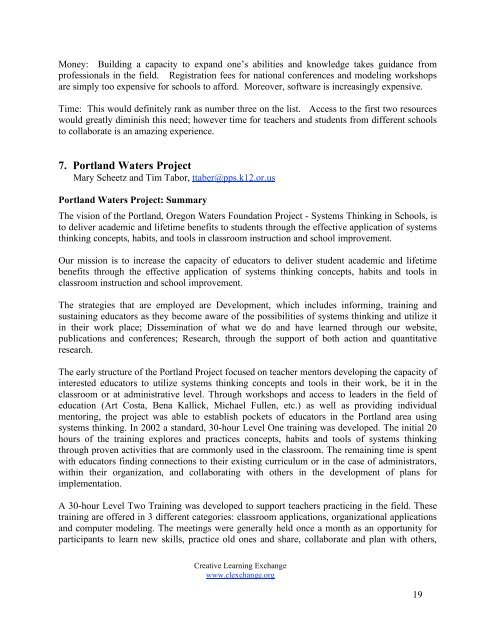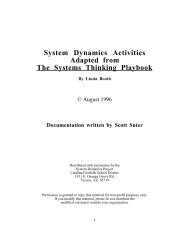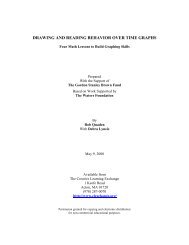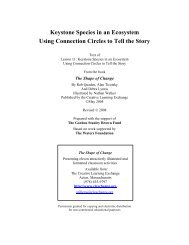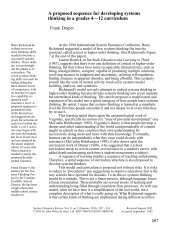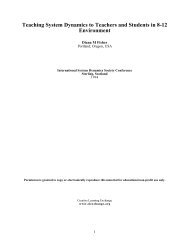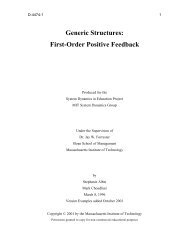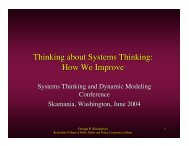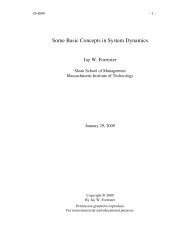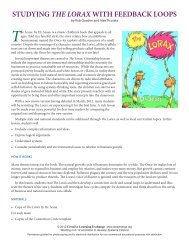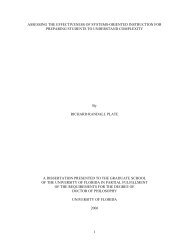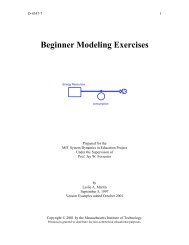System Dynamics in K-12 Education: Lessons Learned - Creative ...
System Dynamics in K-12 Education: Lessons Learned - Creative ...
System Dynamics in K-12 Education: Lessons Learned - Creative ...
You also want an ePaper? Increase the reach of your titles
YUMPU automatically turns print PDFs into web optimized ePapers that Google loves.
Money: Build<strong>in</strong>g a capacity to expand one’s abilities and knowledge takes guidance from<br />
professionals <strong>in</strong> the field. Registration fees for national conferences and model<strong>in</strong>g workshops<br />
are simply too expensive for schools to afford. Moreover, software is <strong>in</strong>creas<strong>in</strong>gly expensive.<br />
Time: This would def<strong>in</strong>itely rank as number three on the list. Access to the first two resources<br />
would greatly dim<strong>in</strong>ish this need; however time for teachers and students from different schools<br />
to collaborate is an amaz<strong>in</strong>g experience.<br />
7. Portland Waters Project<br />
Mary Scheetz and Tim Tabor, ttaber@pps.k<strong>12</strong>.or.us<br />
Portland Waters Project: Summary<br />
The vision of the Portland, Oregon Waters Foundation Project - <strong>System</strong>s Th<strong>in</strong>k<strong>in</strong>g <strong>in</strong> Schools, is<br />
to deliver academic and lifetime benefits to students through the effective application of systems<br />
th<strong>in</strong>k<strong>in</strong>g concepts, habits, and tools <strong>in</strong> classroom <strong>in</strong>struction and school improvement.<br />
Our mission is to <strong>in</strong>crease the capacity of educators to deliver student academic and lifetime<br />
benefits through the effective application of systems th<strong>in</strong>k<strong>in</strong>g concepts, habits and tools <strong>in</strong><br />
classroom <strong>in</strong>struction and school improvement.<br />
The strategies that are employed are Development, which <strong>in</strong>cludes <strong>in</strong>form<strong>in</strong>g, tra<strong>in</strong><strong>in</strong>g and<br />
susta<strong>in</strong><strong>in</strong>g educators as they become aware of the possibilities of systems th<strong>in</strong>k<strong>in</strong>g and utilize it<br />
<strong>in</strong> their work place; Dissem<strong>in</strong>ation of what we do and have learned through our website,<br />
publications and conferences; Research, through the support of both action and quantitative<br />
research.<br />
The early structure of the Portland Project focused on teacher mentors develop<strong>in</strong>g the capacity of<br />
<strong>in</strong>terested educators to utilize systems th<strong>in</strong>k<strong>in</strong>g concepts and tools <strong>in</strong> their work, be it <strong>in</strong> the<br />
classroom or at adm<strong>in</strong>istrative level. Through workshops and access to leaders <strong>in</strong> the field of<br />
education (Art Costa, Bena Kallick, Michael Fullen, etc.) as well as provid<strong>in</strong>g <strong>in</strong>dividual<br />
mentor<strong>in</strong>g, the project was able to establish pockets of educators <strong>in</strong> the Portland area us<strong>in</strong>g<br />
systems th<strong>in</strong>k<strong>in</strong>g. In 2002 a standard, 30-hour Level One tra<strong>in</strong><strong>in</strong>g was developed. The <strong>in</strong>itial 20<br />
hours of the tra<strong>in</strong><strong>in</strong>g explores and practices concepts, habits and tools of systems th<strong>in</strong>k<strong>in</strong>g<br />
through proven activities that are commonly used <strong>in</strong> the classroom. The rema<strong>in</strong><strong>in</strong>g time is spent<br />
with educators f<strong>in</strong>d<strong>in</strong>g connections to their exist<strong>in</strong>g curriculum or <strong>in</strong> the case of adm<strong>in</strong>istrators,<br />
with<strong>in</strong> their organization, and collaborat<strong>in</strong>g with others <strong>in</strong> the development of plans for<br />
implementation.<br />
A 30-hour Level Two Tra<strong>in</strong><strong>in</strong>g was developed to support teachers practic<strong>in</strong>g <strong>in</strong> the field. These<br />
tra<strong>in</strong><strong>in</strong>g are offered <strong>in</strong> 3 different categories: classroom applications, organizational applications<br />
and computer model<strong>in</strong>g. The meet<strong>in</strong>gs were generally held once a month as an opportunity for<br />
participants to learn new skills, practice old ones and share, collaborate and plan with others,<br />
<strong>Creative</strong> Learn<strong>in</strong>g Exchange<br />
www.clexchange.org<br />
19


